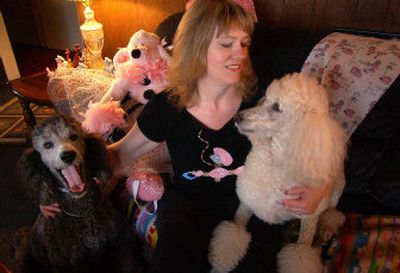For fanciers, poodles are best to show

Fancy Richardson, well coifed and perfectly postured, struts into her mother’s living room like the Queen of the Nile, and it’s easy to see why.
There are tiny porcelain statues of Fancy’s likeness on every available space, a Fancy-esque comforter folded over the back of a sitting chair. In the kitchen, Fancy-style salt and pepper shakers smooch on a shelf above the stove.
Centuries from now, archaeologists sifting through the Spokane Valley gravel for traces of lost civilization on Vista Road might confirm what Fancy has known all along, that she is second in importance only to the sun and that poodles are superior beings.
“They’re the smartest dogs there are,” said Tami Richardson, who regards her waist-high standard poodles, all four of them, as curly-haired children. “They are more like people than any other breed.”
The dogs, Fancy, Paris, Dion and Big Sam, all seem to have bought into this position of privilege. And with 700 pieces of poodle memorabilia scattered around the house, there’s no lack of affirmation.
“All poodle people like poodle things,” explained Pam Furness, a close friend of Richardson’s and a fellow poodle fanatic. We hunt all over for them, but Tami has done something more than most because she’s been collecting for years.”
A dog groomer by trade, Richardson acquired her first poodle in the 1970s. Her mother, Debbie Graham, ran Debbie’s Dog Grooming out of a bedroom in the family’s home on North Farr Road, as well as a boarding business on the side. There was a standard poodle that became one of Graham’s regular boarders and eventually took up residence.
Graham left on the heels of a bad relationship, Richardson said, and the daughter, just 18, picked up the grooming business and her affection for poodles. She now owns Debbie’s Dog Grooming, run out of a First Avenue house sandwiched between the Sprague-Appleway couplet. Her dogs lounge around the shop like Versace models.
Poodles are to the dog world what the Grateful Dead is to rock ‘n’ roll: cultural icons that attract cultlike fans but leave the non-poodle sect wondering what the deal is.
Donna DeHart-Ray became a poodle head 26 years ago after buying a standard poodle pup from Richardson. That first poodle, Lancelot, lead to another, Guinevere, and another, Knight. Those dogs are now long gone, though through the science of cryogenics, Knight is on the verge of becoming a father again, nine years after his death and 11 years after his love life was put on ice. DeHart-Ray believes her own trove of poodle collectables might be larger than Richardson’s. She has poodle door knockers on her Mead home, poodle weather vanes and a bronze of a standard poodle in midrun, among hundreds of other things.
“It’s really sick,” DeHart-Ray said. “I’m sure I should go see a psychologist.”
All poodle people collect things, the women say. And they collect more than owners of other breeds, or at least the market would suggest they do. In the middle of last week, eBay featured 4,530 poodle-related items going, going, gone. Labrador retriever items, on the other hand, numbered 2,524.
The difference in items is significant because Labradors are America’s most popular dogs, according to the American Kennel Club, which tracks registration numbers. The lumbering canines, which wouldn’t recognize a bad hair day if they rolled in one, account for about 145,000 of all dogs registered annually in America. Poodles are a distant seventh; accounting for about 32,000 of all newly registered purebreds. Golden retrievers, Yorkshire terriers, German shepherds, beagles, Dachshunds and boxers all outsell poodles, though all pale when it comes to merchandizing.
Furness is of the opinion that poodle popularity suffers because the pooches are misunderstood, or at least underestimated, even by their owners. Furness, of Spokane Valley, belongs to Versatility in Poodles, or VIP, a group focused on eliminating hereditary health problems, while also getting the breed off of America’s laps and into its fields.
“I’ve taken my dogs herding and tracking,” Furness said. “When you go herding, the owners of the dogs in the herding group are like ‘ouch that’s a prissy dog.’ But if you don’t tell (poodles) they’re prissy, they’re not.”
Poodles were used in Germany for hunting bears because of their sharp minds and “fearlessness in the face of overwhelming odds.” The root of the dog’s name is Pudeln, Richardson said, the German word for splashing in water. The French claim the animal, but so do the Italians and Russians.
The animals were bred by Germans to be water dogs primarily. The little pompoms of hair left around the shaven dog’s ankles are a throwback to the days when a little fur was thought to keep the animal’s joints warm and limber while swimming in frigid waters.
There is evidence of poodles dating back to the time of Jesus Christ. The dogs appear on the walls of Roman tombs and the coins of ancient Greece. Fancy Richardson wouldn’t be surprised.